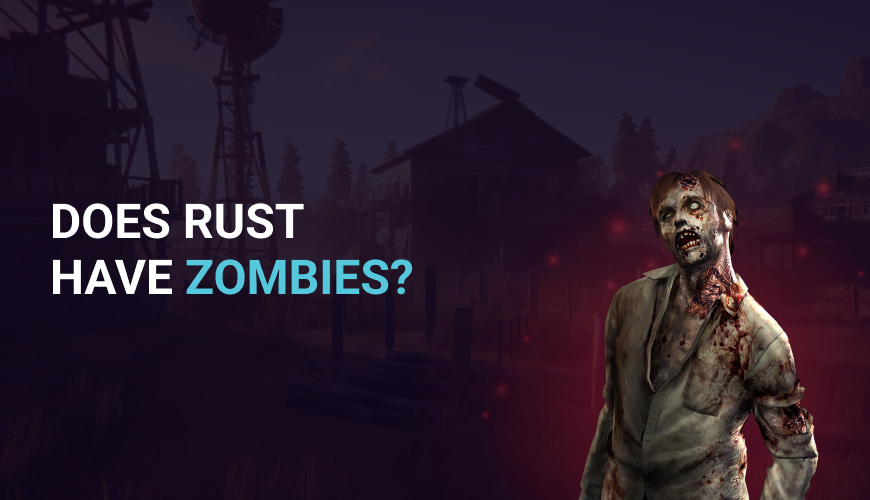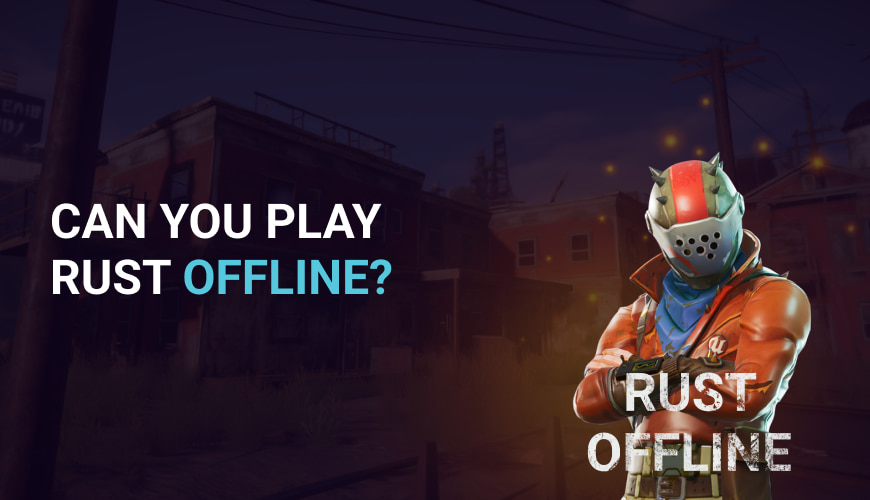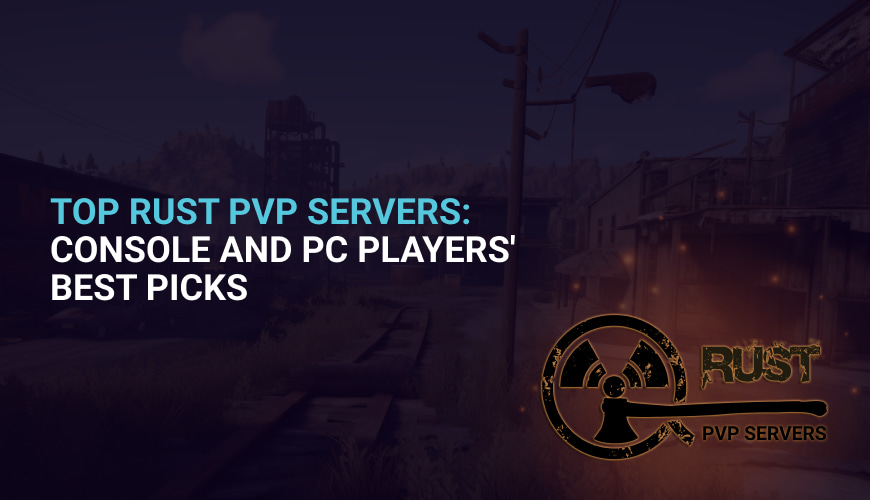There are a lot of action games like TF2, CS or Dota. But Rust stands out as one of the most original. It has captured the hearts of gamers worldwide with its brutal and unforgiving gameplay, immersive world, and the constant struggle for survival.
The game has evolved significantly since its initial release. But one element that has piqued the curiosity of players is zombie-like creatures.
In this Mannco Store blog post, we'll delve into the world of Rust. We will focus on its history and its current state, examining whether there are zombies in Rust
The World of Rust
Rust takes place in a post-apocalyptic world where players find themselves marooned on an island inhabited by various dangers, including other players and AI-controlled entities. This stark and relentless environment is characterized by the necessity to:
-
Gather resources.
-
Build shelters.
-
Fend off threats to stay alive.
The island is a vast and varied landscape. It encompasses desolate wastelands, dense forests, craggy mountains, and sprawling coastlines. This diversity adds to the richness of the gameplay experience. And players must adapt to different terrains and climates to survive. Before diving into where to find zombies in Rust, let’s focus on the features of the game.
A Survival Game Unlike Any Other
One of the standout features of Rust is its intense and unscripted interactions. Players must be constantly vigilant, as danger can strike at any moment. The freedom to form alliances or betray others adds an element of unpredictability. In this dynamic sandbox, players must be adaptable and resourceful to survive, not even speaking about heading to areas where they can find zombies in Rust.
Player interactions can often be brutal and cutthroat. But they can also be cooperative and creative. The game's building mechanics allow players to construct elaborate fortresses and structures. It may serve as bases, homes, or even elaborate traps. It's to protect resources or catch unsuspecting rivals. The balance between cooperation and competition makes Rust a unique and unpredictable experience.
The Early Days of Zombies in Rust
In the early days of Rust, zombies roamed the landscape. They added an extra layer of challenge to the game's already punishing experience.
This period of Rust's development marked a unique era in the game's history.
In this section, we'll take a nostalgic journey back to those days. We will revisit the times when zombies were a significant threat.
We'll delve into their behavior, the strategies players employed to deal with them, and the ways in which the game has evolved since then.
The Origins of Zombie-Like Creatures
In the early days of the Rust game, the game indeed included zombie creatures. These entities were known as "zombies". And they're reminiscent of classic undead foes found in many survival games. They roamed the landscape, presenting an extra threat to players trying to survive. These zombies exhibited typical zombie behavior, wandering aimlessly, and attacking players on sight.
The inclusion of zombies in the game served several purposes. They provided a steady source of PvE (Player vs. Environment) encounters. It added variety to the gameplay. Players had to contend with both the hostile wildlife and these undead creatures. Moreover, zombies were an extra source of valuable resources, such as loot and crafting materials. It motivated players to engage with them.
The Role of Zombies in Early Rust
The role of Rust zombies in early iterations extended beyond being mere cannon. They played a role in establishing the game's eerie and hostile atmosphere. The constant threat of zombies added a layer of tension to the game. It made players question every move they made and the resources they expended.
But zombies were not without their limitations. They became somewhat predictable over time. And their behavior could be exploited by experienced players. The challenges they posed were less diverse and dynamic compared to the evolving landscape of Rust. Thus, as the game continued to develop, the role of zombies underwent changes.
The Evolution of Rust
As Rust evolved, the presence of traditional survival zombies gradually faded. The developers at Facepunch Studios opted for a more realistic and immersive approach. This decision led to the removal of zombies. They're replaced with alternative threats and challenges.
The Current State of Rust
The current state of Rust represents an ever-evolving and dynamic world. It's constantly shaped by both the game's developers and its passionate player community. As of the most recent updates, Rust continues to be captivating and unpredictable.
In this section, we will immerse ourselves in the contemporary landscape of Rust. We will explore its gameplay dynamics, community involvement, and the latest features. We'll discuss the ongoing evolution of the game and the strategies that are currently effective. Stay with us, as we provide a snapshot of the ever-shifting world of Rust.
Changes in Gameplay and Challenges
The removal of Rust zombies was just one of the many changes the game underwent as it evolved. The game's development team continued to refine the gameplay, mechanics, and player experience. Rather than relying on undead adversaries, Rust introduced a diverse set of challenges. It's to maintain a high level of engagement.
Environmental Hazards
To compensate for the absence of zombies, Rust introduced various environmental hazards. Harsh weather conditions, radiation, and wildlife became central elements of the game. These environmental factors posed a different kind of challenge. And they further contributed to the immersive, unpredictable nature of the world.
Rust's environmental hazards can be especially unforgiving. A sudden radiation or freezing can turn the tables on an unsuspecting player. These environmental challenges force players to plan carefully. They must dress appropriately and seek shelter when needed. They add an extra layer of realism to the game, creating a world where survival is about more than just combat.
NPC Factions
In place of traditional survival Rust zombies, the game introduced NPC factions. These factions included scientists, bandits, and wildlife. Each has its unique characteristics and behaviors. The inclusion of these NPCs added complexity to the game's social dynamics. And it provided a new layer of gameplay.
As for the Rust zombies, players can also play on maps with zombie characters. But, in this case, they need to look for servers with zombie modes. Such servers do not give the feeling that was in the original game. But players can at least somewhat enjoy the deleted mode from the original game.
As for the other characters:
-
Scientists. They’re often found near high-tech research areas. And they're equipped with advanced weapons and armor. They acted as protectors of these sites. They pose a formidable threat to players who attempt to access valuable resources.
-
Bandits. They’re roving groups of AI-controlled antagonists, often found in the game's wilderness. They could be hostile, but they could also be negotiated with or even aligned with to raid other players. The unpredictability of these bandits added an extra layer of diplomacy and danger.
-
Wildlife. They’re bears and wolves. They became more significant threats like Rust game zombies were. Encounters with these creatures could lead to a battle for survival. It's especially in the early stages of the game. Then, players had limited resources and equipment.
The Pursuit of Realism
Rust game’s evolution focused on making the game world feel more realistic and believable instead of using creatures like zombies The introduction of various hazards and challenges. It's to create an environment that resonates with players. The game's commitment to realism extends to its crafting system, base building mechanics, and the need for sustenance, all of which contribute to the immersive experience.
Players must gather resources to construct shelters. They need to craft tools, and weapons and ensure they have enough food and water to survive. This realistic survival aspect is at the core of Rust's appeal. The emphasis on realism extends to the extensive crafting system. It allows players to create everything from simple tools to advanced weaponry.
Conclusion
In the world of the game, there are zombies in Rust as part of its early history. These zombie-like creatures served as a source of PvE encounters. But Rust opted for a more realistic and immersive approach, gradually removing zombies and replacing them with a diverse set of challenges, including environmental hazards and NPC factions.
Traditional zombies may no longer be a part of Rust. But the spirit of relentless survival and the interactions remain fundamental elements. Rust has demonstrated its ability to adapt and redefine itself. It ensures players always have new challenges to face in their quest for survival. Whether it's facing the elements, negotiating with ruthless bandits, or fending.




0 comments
Add a comment